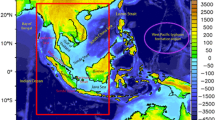Abstract
In order to research the interactions between the atmosphere and ocean as well as their important role in the intensive weather systems of coastal areas, and to improve the forecasting ability of the hazardous weather processes of coastal areas, a coupled atmosphere-ocean-wave modeling system has been developed. The agent-based environment framework for linking models allows flexible and dynamic information exchange between models. For the purpose of flexibility, portability and scalability, the framework of the whole system takes a multi-layer architecture that includes a user interface layer, computational layer and service-enabling layer. The numerical experiment presented in this paper demonstrates the performance of the distributed coupled modeling system.
Similar content being viewed by others
References
Ahrem, R., M. G. Hackenberg, U. Karabek, P. Post, R. Redler, and J. Roggenbuck, 1996: Specification of MpCCI. Technical Report 1.2, GMD-SCAI, Sankt Augustin, Germany, 1–78.
Branstetter, M. L., and D. J. Erickson, 2003: Continental runoff dynamics in the Community Climate System Model (CCSM2) control simulation. J. Geophys. Res., 108, 4550–4566
Bryan, F. O., B. G. Kauffman, W. G. Large, and P. R. Gent, 1996: The NCAR CSM Flux Coupler. Technical Report TN-425+STR, National Center for Atmospheric Research, Boulder, Co., 70pp.
Blumberg, A. F., 1994: A primer for ECOM-si. Technical Report, HydroQual, Inc., Mahwah, 57pp.
Doyle, J. D., 2002: Coupled Atmosphere-Ocean Wave Simulations under High Wind Conditions. Mon. Wea. Rev., 130, 3087–3099.
Dudhia, J., D. Gill, K. Manning, W. Wang, C. Bruyere, S. Kelly, and K. Lackey, 2005: PSU/NCAR Mesoscale Modeling System Tutorial Class Notes: MM5 Modeling System Version 3, 117pp.
Hodur, R. M., 1996: The Naval Research Laboratory’s Coupled Ocean/Atmosphere Mesoscle Prediction System COAMPS. Mon. Wea. Rev., 125, 1414–1430.
Larson, J. W., R. L. Jacob, I. Foster, and J. Guo, 2001: The Model Coupling Toolkit. Proc. 2001 International Conf. on Computational Science, 185–191.
Lee, C., C. Chiang, and M. Horng, 2000: Collaborative Web Computing Environment: An Infrastructure for Scientific Computation. IEEE Internet Computing, 4(2), 27–35.
Liu Xiying, Zhang Xuehong, Yu Yongqiang, and Yu Rucong, 2004: Mean climatic characteristics in high northern latitudes in an ocean-sea ice-atmosphere coupled model. Adv. Atmos. Sci., 21(2), 236–244.
Markus, S., and Coauthors, 2000: An agent-based netcentric framework for multidisciplinary problem solving environments. International Journal of Computational Engineering Science, 1, 33–60.
Power, J. G., Mark T. Stoelinga, and W. S. Boyd, 1997: Distributed numerical weather prediction via satellite. Bull. Amer. Meteor. Soc., 78(12), 2755–2770.
Terray, L., A. Piacentini, and S. Valcke, 2000: Oasis 2.4, Ocean Atmosphere Sea Ice Soil: User’s Guide, Technical Report TR/CMGC/00/10, CERFACS, Toulouse, France, 73pp.
Walkley, M., J. Wood, and K. Brodlie, 2002: A distributed co-operative problem solving environment. Lecture Notes in Computer Science, 2329, 853–861.
Weisse, R., and E. F. Alvarez, 1997: The European Coupled Atmosphere Wave Ocean Model ECAWOM. Max-Planck-Institut für Meteorologie, Report No. 238, Hamburg, Germany, 35pp.
Wen, Y., S. Yu, J. Zhou, and L. Huang, 2004: Agent based distributed parallel tunneling algorithms. Lecture Notes in Computer Science, 3320, 226–230.
Wu Guoxiong, Liu Hui, Zhao Yucheng, and Li Weiping, 1996: A nine-layer atmospheric general circulation model and its performance. Adv. Atmos. Sci., 13, 1–18.
Wu Guoxiong, and Coauthors, 1997: Global Ocean-Atmosphere-Land System model of LASG (GOALS/LASG) and its performance in simulation study. Quarterly Journal of Applied Meteorology, 8, Supplement, 15–28. (in Chinese)
Xue, H., and Pan Z., 2000: A 2D coupled atmosphere-ocean model study of air-sea interactions during a cold air outbreak over the Gulf Stream. Mon. Wea. Rev., 128, 973–996.
Xue, M., K. K. Droegemeier, V. Wang, A. Shapiro, and K. Brewster, 1995: Advanced Regional Prediction System User’s Guide. University of Oklahoma, 67pp.
Yu Rucong, and Xu Youpin, 2004: AREAM and its simulations on the daily rainfall in summer in 2003. Acta Meteorologica Sinica, 62, 715–724.
Yu Yongqiang, Yu Rucong, Zhang Xuehong, and Liu Hailong, 2002: A flexible global coupled climate model. Adv. Atmos. Sci., 19, 169–190.
Zebiak, S. E., and M. A. Cane, 1987: A model El Niño-Southern Oscillation. Mon. Wea. Rev., 115, 2262–2278.
Zhou Tianjun, Yu Yongqiang, Yu Rucong, Liu Hailong, Li Wei, and Zhang Xuehong, 2004: Coupled climate system model coupler review. Adv. Atmos. Sci., 28, 993–1008.
Author information
Authors and Affiliations
Rights and permissions
About this article
Cite this article
Wen, Y., Huang, L., Deng, J. et al. Framework of distributed coupled atmosphere-ocean-wave modeling system. Adv. Atmos. Sci. 23, 442–448 (2006). https://doi.org/10.1007/s00376-006-0442-2
Received:
Revised:
Issue Date:
DOI: https://doi.org/10.1007/s00376-006-0442-2




